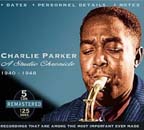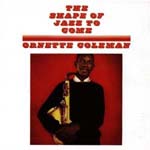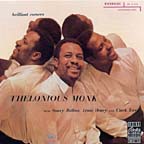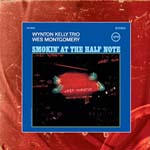|

|

|
|
|
|
Part
5
Essential Recordings
|
|
Jazz Essentials, Part 5
Five ground-breaking
individuals of jazz
By Tom
Ineck
In this
installment of essential jazz recordings, we again recommend CDs by five
significant jazz artists who excelled on their instruments of choice.
This time we explore their music as much for its groundbreaking
originality as for the players’ technical mastery. By looking at two
alto saxophonists, two pianists and a very influential guitarist, it
will help us understand to what degree jazz is a musical form best
defined by the individual.
No one has had a
greater impact on the development of modern jazz than alto saxophonist
Charles "Yardbird" Parker, who virtually invented the bebop style
within the context of a small combo—usually a quintet also featuring
trumpet, piano, bass and drums—in sharp contrast to the big band swing
that preceded Parker’s emergence in the early 1940s. An undisputed
virtuoso on his horn, he redirected the focus of jazz from simple
melodic progressions to improvisations based on chords, essentially
creating new song structures as a basis for endless exploration by the
soloists. The concept was earth-shaking for its time, sparking a
backlash that included Louis Armstrong’s characterization of bebop as
"Chinese music."
Another
controversial alto saxophonist who would turn the jazz world on its ear
in the late 1950s was Ornette Coleman, whose "harmolodic" system
abandoned bebop’s concentration on harmony in favor of free
improvisation loosely based on melodic themes and moods. Coleman’s odd
technique and shrill, wavering tone can be off-putting to a novice. Even
more than Parker, Coleman upset the jazz establishment’s apple cart,
drawing ire from Miles Davis, among others. Now 80, Coleman still
eschews convention and still sounds fresh and uncompromising.
With his odd
chord progressions, his quirky, crablike piano technique and his often
unsettling personal demeanor, the ultimate jazz iconoclast may be
Thelonious Sphere Monk. One of the architects of the bebop movement,
Monk’s keyboard innovations and advanced concepts made him unique among
his contemporaries. Dozens of his memorable compositions—including
"Straight No Chaser," "Well You Needn’t" and the haunting ballad "’Round
Midnight"—still intrigue young players and present unique challenges to
interpretation.
On the other
extreme of the spectrum is the piano style of Bill Evans, who
opted for a more fluid approach reminiscent of chamber music. During his
brief eight-month tenure with Miles Davis, Evans provided a perfect foil
for the trumpeter’s modal excursions, especially on the landmark 1959
recording "Kind of Blue." Evans is heard to best effect on his numerous
trio recordings, where he often transformed jazz standards with
interpretations uniquely his own. He also wrote such memorable tunes as
"Waltz for Debby," "Time Remembered," "Song for Helen" and "Peace
Piece."
Perhaps no
guitarist has been as influential among jazz players as Wes
Montgomery. Self-taught using his thumb instead of a pick, he
developed an individual technique by chording octaves instead of
plucking single-note runs. Recording his first session as a leader in
1959, he established his formidable reputation and solidified his place
in jazz history in less than a decade. His recording career ended with
his death of a heart attack in 1968, at age 43.
CHARLIE PARKER
 A
Studio Chronicle 1940-1948 A
Studio Chronicle 1940-1948
JSP
Records
There are many
impressive anthologies of Parker’s ground-breaking early music, but this
is probably the one to go with if you can find it. It compiles 125
re-mastered Dial and Savoy recordings from 1940 to 1948 on five discs
and generally sells for about $30. It includes Jay McShann sides "Swingmatism"
and "Hootie Blues," plus many of the tunes on which Parker established
his credentials—"Tiny’s Tempo," "Red Cross," "Groovin’ High," "Hot
House," "Billie’s Bounce," "Now’s the Time," "Yardbird Suite,"
"Ornithology," "Cool Blues," "Relaxin’ at Camarillo," "Donna Lee,"
"Scrapple from the Apple," "Parker’s Mood," and many more. It is hard to
believe that Parker was just 19 or 20 years of age when these recordings
began and not yet 30 when this very productive period ended. He would
live just another seven years, dying at the age of 34. Another
recommended boxed set documenting Parker’s early years is the three-disc
"The Complete Savoy and Dial Masters" on Savoy Jazz. It’s easier to find
but more expensive than the JSP collection. "The Complete Dial Sessions"
is a four-disc set on Stash Records that includes some superfluous
alternate takes.
ORNETTE COLEMAN
 The
Shape of Jazz to Come The
Shape of Jazz to Come
Atlantic
Records
The first
half-dozen or so of Coleman’s break-through recordings (1958-1961) still
dazzle with their originality. We will go with 1959’s "The Shape of Jazz
to Come" for its major-label introduction of some very un-mainstream
music. Among the best tracks are "Lonely Woman," "Congeniality" and
"Peace." Of course, the sidemen in Coleman’s classic quartet are all in
good form—trumpeter Don Cherry, bassist Charlie Haden and drummer Billy
Higgins. This is considered by many to be the Holy Grail of avant-garde
jazz, but other worthy Coleman classics include "Something Else!!!!: The
Music of Ornette Coleman" (1958), "Tomorrow is the Question" (1959),
"Change of the Century" (1960), and "The Art of the Improvisers" (1961).
THELONIOUS MONK
 Brilliant
Corners Brilliant
Corners
Original
Jazz Classics
Like Coleman,
the music of Thelonious Monk stands outside the mainstream for its
unconventional sound and audacity of style and technique. No one else
could have written "’Round Midnight," "Well You Needn’t" or any of
dozens of Monk compositions that bear his unmistakable stamp. The
seminal 1957 release "Brilliant Corners" introduced "Bemsha Swing," "Pannonica,"
"Ba-Lue Bolivar Ba-Lues-Are," and the title track. Among the outstanding
sidemen are tenor saxophonist Sonny Rollins, drummer Max Roach, bassist
Oscar Pettiford, and alto saxophonist Ernie Henry. "Bemsha Swing"
features trumpeter Clark Terry and bassist Paul Chambers, and Monk’s
performs a solo piano rendition of the standard "I Surrender, Dear."
BILL EVANS
 The
Complete Village Vanguard Recordings, 1961 The
Complete Village Vanguard Recordings, 1961
Riverside
Records
Evans amassed an impressive
catalog of recorded music before his death in 1980 at age 51. Some of
his best work was documented live with a trio that also featured bassist
Scott LaFaro and drummer Paul Motian. During five sets on June 25, 1961,
they created this classic of modern jazz. Released in piecemeal fashion
over the years, the entire three-disc package was finally re-mastered
and reissued in 2005. It contains superb interpretations of Evans’
"Waltz for Debby" and LaFaro’s "Gloria’s Step" and "Jade Visions," but
the real treasures are the trio’s inspired performances of standards
such as "My Foolish Heart," "My Romance," "Some Other Time," "I Loves
You Porgy," "Alice in Wonderland," "All of You" and Miles Davis’
"Solar." Evans demonstrates why his lyrical, intense romanticism has
influenced several generations of modern jazz piano players, from Chick
Corea and Herbie Hancock to Keith Jarrett, Fred Hersch and Brad Mehldau.
WES MONTGOMERY
 Smokin'
at the Half Note Smokin'
at the Half Note
Verve Records
Like Evans, much
of Montgomery’s finest recordings were captured in live performances,
including 1962’s "Full House" and this one from 1965. "Smokin’" is
especially noteworthy because it comes later in the guitarist’s career,
when his studio recordings had taken on a well-polished and
well-marketed commercial patina that often discouraged or obscured his
dazzling fret board technique behind an orchestral pop luster. This set
is a mid-‘60s exception to that rule, an example of Montgomery’s playing
at its most inspired. This performance has been packaged in several
versions, including the original five-track release—featuring blistering
renditions of "Unit 7" and "Four on Six"—and this 2005 re-mastered
version with six additional tracks. Among the most notable are "Willow
Weep for Me," "The Surrey with the Fringe on Top," and "Impressions."
Throughout, Montgomery is masterfully accompanied by the Wynton Kelly
Trio—pianist Kelly, bassist Paul Chambers and drummer Jimmy Cobb.
top |
|
|
|

 A
Studio Chronicle 1940-1948
A
Studio Chronicle 1940-1948 The
Shape of Jazz to Come
The
Shape of Jazz to Come Brilliant
Corners
Brilliant
Corners The
Complete Village Vanguard Recordings, 1961
The
Complete Village Vanguard Recordings, 1961 Smokin'
at the Half Note
Smokin'
at the Half Note